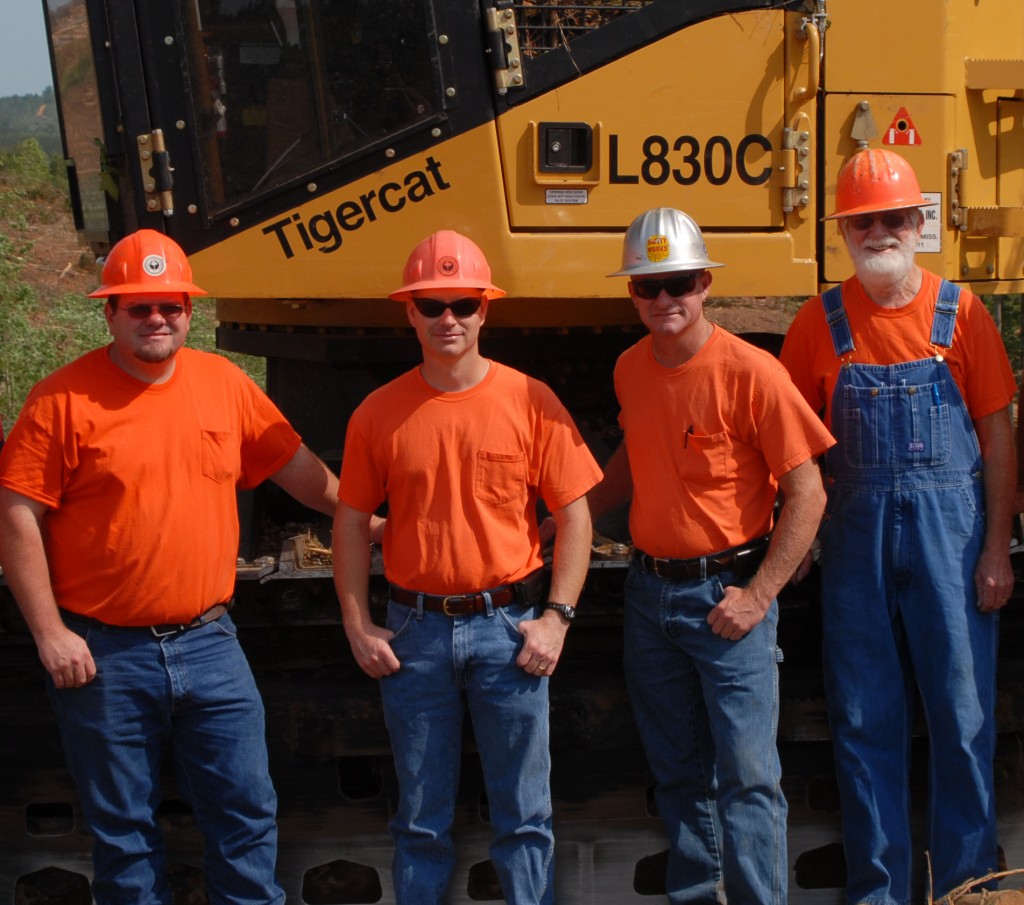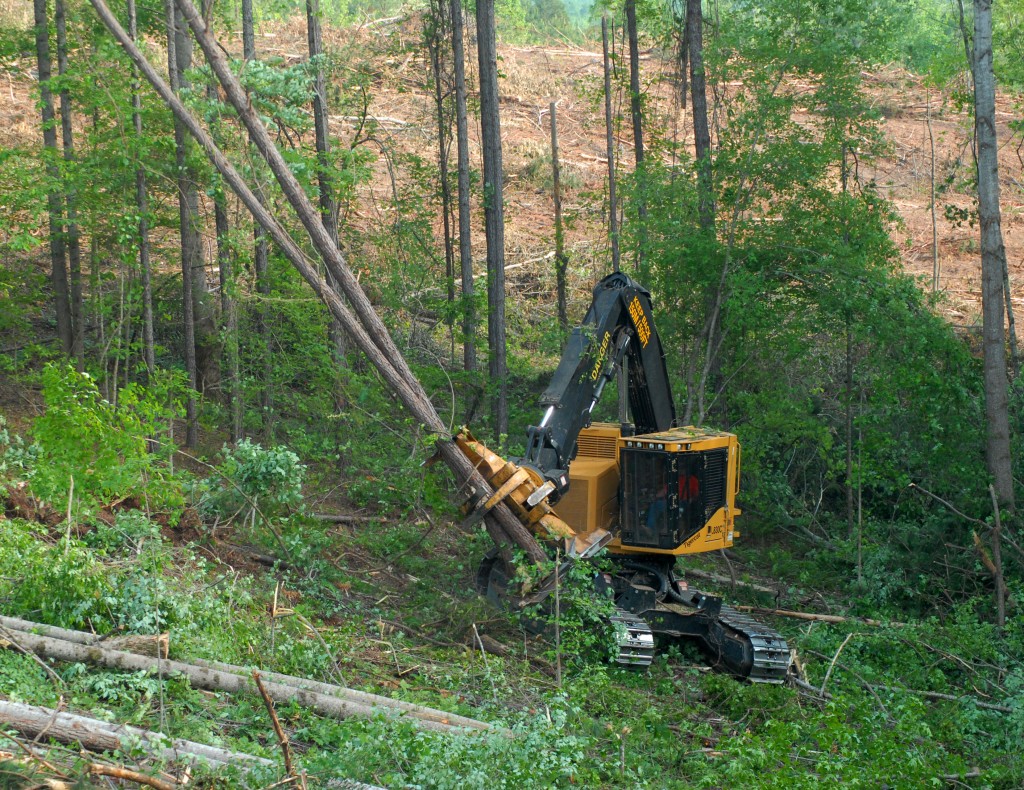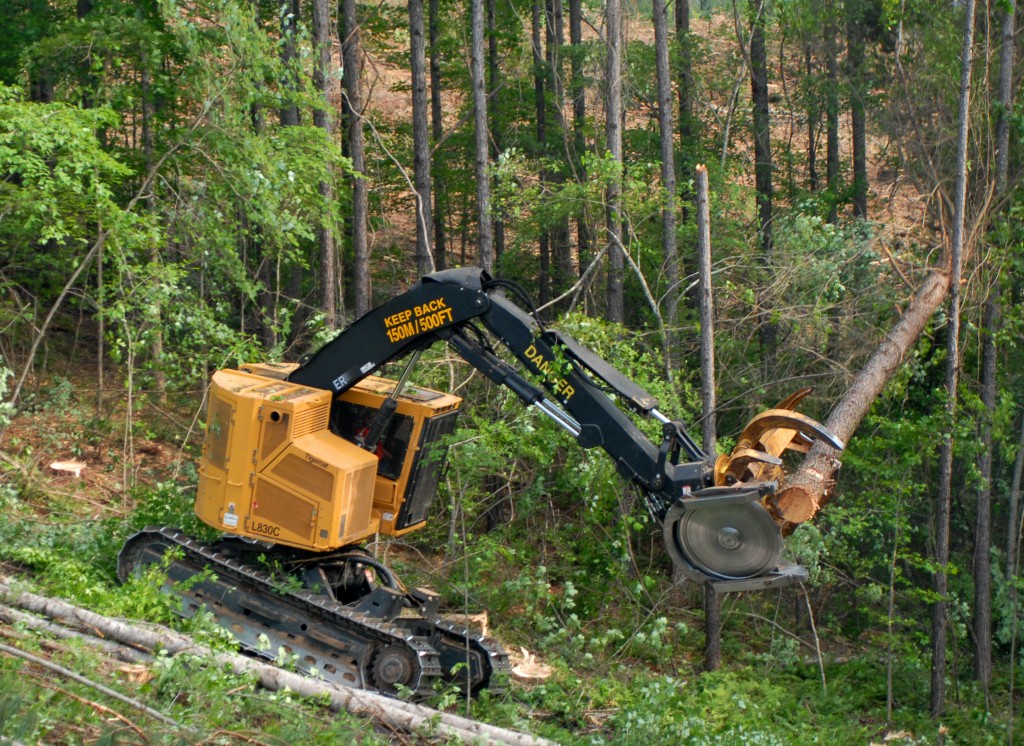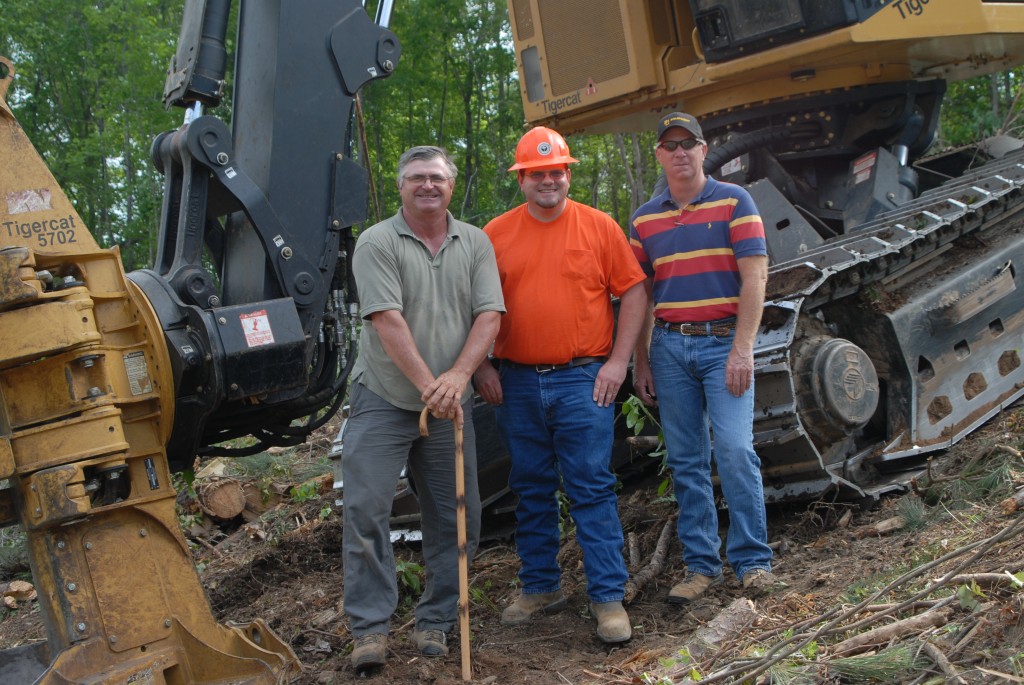1st July 2012
In April 2011 Derrick O’Bryant toured the Tigercat facilities as part of a fact finding mission. Derrick was representing TDK Logging, a family owned business started by his father Edwin (Sam) O’Bryant thirty years prior.
— Paul Iarocci
Today the company is run by Sam and his three sons, Tim, Kevin and Derrick. Daughter, Samantha is the office manager.
Specializing in harvesting timber from some of Weyerhaeuser’s most challenging blocks along the hilly Mississippi – Alabama border, the family had decided that they were in a solid financial position to purchase a leveling track feller buncher, a machine that they all agreed would be a great asset to their operations.

Family business. Derrick, Kevin, Tim and Sam O’Bryant.
TDK has fourteen employees in total with six men working in the woods and six truck drivers. The company cuts exclusively for Weyerhaeuser on the ridges, valleys and gullies of eastern Mississippi. The company was the first and remains the only contractor in the state to run a processor, which is operated by Kevin. Tim runs a track loader on the deck and until this year Derrick operated a wheel feller buncher. “It helps to have operators who are invested in the company,” remarks Derrick.

TDK’s L830C feller buncher working a mixed stand in eastern Mississippi.
Due to the terrain, the deck areas are often small and congested. (In 2008, they elected to purchase the processor, getting rid of the larger-footprint and less-flexible pull through delimbers, while improving merchandising capability.) The slopes are generally 60-75 ft (18-23 m) high and 200-300 ft (60-90 m) in distance from the bottom to the top of the ridges. On average, the tracts are composed of 70% pine and 30% mixed hardwood, generally up to a maximum 24 in (610 mm) diameter.
Deep down, Derrick knew that for the short, steep slopes that he was encountering on a daily basis, a wheel buncher was not the optimal felling solution. The main issue was that the wheel machine simply could not get to all the merchantable timber, not just due to steep slopes of up to 35% grade but also because of soft ground in the cuts and valleys. “We decided that after the processor was paid off we would purchase a track cutter,” explains Derrick. “We could have bought another wheel cutter for way less money and struggled on or bought a track cutter that is well matched to the job.”

Powerful swing torque and the 340 degree wrist allows Derrick to optimally position the trees for the skidder with little additional track movement.
Although Derrick had never run a track feller buncher before, he did not let his lack of experience deter or intimidate him. “We made a trip to the Tigercat factory in April 2011 to help make the decision,” he recounts. After getting a good description of TDK’s typical operating conditions and spending hours discussing the relative merits of Tigercat’s various feller buncher models, the designers in the track group and Tigercat president Tony Iarocci began to steer Derrick towards an L830C leveling buncher.
Derrick says that the factory trip really helped with the decision of whether to go with Tigercat or Deere and also crystallized the differences between the L830C, 845C and 860C/870C models. “We decided we needed the zero tail-swing. The L830C is like a crunched up 870C. It has all the power and most of the stability of the 870C but with zero tail-swing and more leveling. The disadvantage is that the access is worse, but you can still get to everything.”
Although Derrick was leaning hard toward Tigercat after the factory visit, there was still family pressure to go with a Deere buncher. At the time TDK owned a complete fleet of Deere machines – bunchers, skidders, loaders and processors and had never run a Tigercat. District manager, Johnny Boyd, and veteran B&G Equipment salesman, Johnny Burton, wondered if TDK would break from tradition and try a Tigercat.
“Dad wanted a 759K but it is just too small. Deere doesn’t offer a powerful, compact machine.”
Nevertheless, the family did keep an open mind, fully exploring alternatives to the L830C, namely a full tail-swing Deere machine. “Me and Tim went to Oregon in July 2011 and saw a 959K. We were surprised at how big it was and how much tail-swing there was,” says Derrick. Aside from the overall size of the machine, Derrick saw other disadvantages. “The tilt cylinders and leveling system just wasn’t there. And I didn’t like the cab. I like how roomy the 830 cab is. And the pilot system and controls are way better. The Deere electronic controls are jumpy.”
After watching the 959K work for a few hours, Derrick and Tim went to see Mark Gustafson’s LX830C. It was an informative visit. Mark has a great deal of experience both with steep slopes and Tigercat feller bunchers, having purchased his first L830 nearly ten years ago. “We were really impressed,” says Derrick and upon returning to Mississippi they broke the news to Sam.
“We told Daddy that Tigercat was the way to go even though the financing would be more challenging than the Deere financing that we are used to,” says Derrick. “Tigercat put the machine into production early for us. We had direct contact with the factory during the time it was being built. Judy Brooks [Tigercat marketing assistant] even sent me pictures of my machine on the line through the various stages of assembly.”
Derrick emphasizes that the L830C is improving fibre recovery rates while making the entire harvesting system more efficient. First off, he is able to top the large hardwood trees. “It helps the skidders out,” Derrick explains. “And the 5702 Tigercat head with the 340 rotate wrist lets me put the wood wherever I want.” By placing the wood more optimally, the skidder operator can reduce travel and minimize his exposure to the steepest sections of the blocks, decreasing cycle times and fuel consumption. This also helps to prevent soil erosion. Derrick is impressed with the overall machine performance, citing the quickness of the ER boom as well as the powerful swing torque.

One happy operator. Derrick O’Bryant flanked by Tigercat district manager, Johnny Boyd and B&G salesman, Johnny Burton.
Suffering from a painful arthritic condition, Derrick says that operating the track machine is much easier on him. “I feel like I am not straining anymore and I don’t hurt anymore after work, the way I did when I was running the wheel cutter. I would never go back to a wheel cutter. It is easier on us and the application puts less stress on a track machine.”
Derrick claims that the L830C only burns about 1.5 gallons (5,5 L) more per hour than a wheel feller buncher while significantly out-producing it. “It is easy to justify the extra cost. And we always try to do preventative maintenance,” says Derrick. “If you do a little bit now, it saves you a lot down the road. We are looking at getting 20 000 hours out of this machine. If you do good maintenance on this stuff, it will run a lot longer.”
The O’Bryants’ only complaint is the size of the fuel tank. They reason that if it held 30 gallons more, they would be able to get a full two days of operation before having to refuel. But Derrick does appreciate the ground level fueling system. “It keeps you off the machine while refueling which is a lot safer.”
Coming off a wheel feller buncher, Derrick had no experience with a swing boom track machine, yet at under 400 hours, Derrick is looking like an experienced operator. “I just ran it and experimented with the machine. After 100 hours or so I got the hang of it. My style of cutting is different from Canadian operators because we have different conditions. We cut year round and we have wetter ground. The blocks have less density, lots of species and a lot of underbrush. And the wood dries out very quickly in the summer so we lose a lot of tonnage if it stays on the ground too long.”
TDK elected to keep the old wheel buncher and now the other operator can move between it and a skidder as required. Derrick explains that this is necessary since he looks after machine maintenance. “We don’t have a full time maintenance guy on the ground. I do the maintenance most of the time, so the extra machine helps guarantee flow of wood when I am not operating my machine.” He goes on to say that the wheel buncher can always be deployed to the flats and ridge tops.
“Hands down, Tigercat makes a jam up track cutter,” says Derrick. “We might see some more Tigercat equipment in the future.”